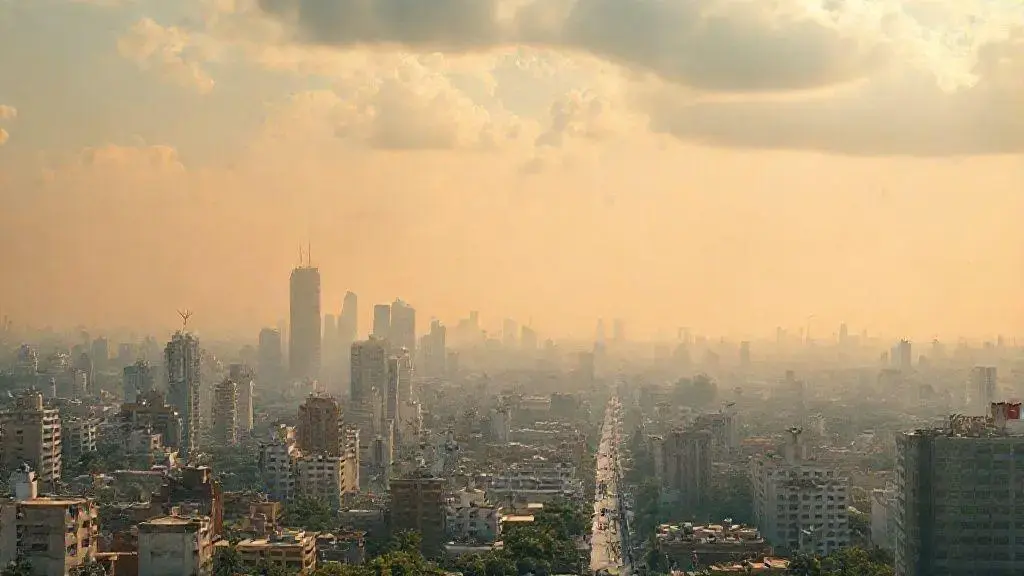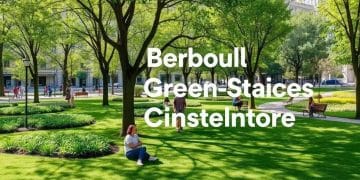Heat dome effects on cities: what you need to know

Heat dome effects on cities lead to dangerously high temperatures, significantly impacting public health, with communities needing to implement strategies like tree planting and cooling centers to mitigate these risks.
Heat dome effects on cities can be profound, leading to rising temperatures that amplify urban heat islands. Have you ever wondered how these phenomena affect our daily lives and the environment? Let’s dive into the details.
Understanding heat domes and their formation
To truly grasp the heat dome effects on cities, it’s essential to understand what a heat dome is and how it forms. A heat dome occurs when high-pressure systems trap warm air in a specific area, leading to dangerously high temperatures.
The warm air gets stuck underneath a layer of cooler air, causing temperatures to soar. This phenomenon is more common in urban environments due to the heat-absorbing materials like concrete and asphalt.
How do heat domes develop?
Heat domes typically form during summer months. As the sun heats the Earth’s surface, the warm air rises. In certain situations, a ridge of high pressure forms, which prevents cooler air from entering the area. This leads to :
- Continuous heating of the region.
- Increased ground-level temperatures.
- Stagnation of air, which can worsen pollution levels.
Essentially, a heat dome can trap pollutants, making air quality worse for residents. Urban areas may face additional challenges such as:
- Higher energy demands for cooling.
- Heat-related illnesses like heat exhaustion.
- Increased mortality rates.
The persistence of these high-pressure systems means that cities can experience prolonged periods of heat, leading to serious health and environmental impacts.
Health impacts of heat domes on urban residents
The health impacts of heat domes on urban residents can be severe, especially during extreme temperature events. Heat domes can lead to a variety of health issues, affecting vulnerable populations the most.
As temperatures climb, the risk of heat-related illnesses increases significantly. This includes conditions such as heat exhaustion and heat stroke, which can be life-threatening if not addressed promptly.
Vulnerable populations
Certain groups are more susceptible to these heat-related health impacts:
- The elderly, who may have a reduced ability to regulate their body temperature.
- Children, as they are less able to cope with high temperatures.
- Individuals with pre-existing health conditions, such as heart disease or respiratory issues.
Urban residents often experience amplified heat due to the urban heat island effect. This phenomenon occurs when cities absorb and retain more heat than surrounding areas, leading to dangerously high local temperatures. In these conditions, people may find it challenging to access adequate cooling resources, making the situation more critical.
Prolonged exposure to extreme heat can also lead to dehydration, which further exacerbates health problems. In addition, high temperatures can worsen air quality, leading to respiratory complications for many individuals.
Preventive measures
To combat the health impacts of heat domes, individuals and communities can take various preventive measures:
- Staying hydrated by drinking plenty of water.
- Seeking air-conditioned environments, like libraries or community centers.
- Limiting outdoor activities during peak heat hours.
Being aware of the warning signs of heat-related illnesses is crucial. Symptoms such as headaches, dizziness, and nausea should never be ignored. By taking proactive steps, urban residents can help protect themselves and their loved ones during heat events.
How cities can adapt to rising temperatures

As climate change continues to impact the planet, understanding how cities can adapt to rising temperatures is crucial. Cities face unique challenges due to their dense populations, and implementing effective strategies is essential for the well-being of residents.
One effective approach involves increasing green spaces. Parks and urban forests can cool down areas significantly. Plants absorb sunlight and provide shade, helping to reduce the urban heat island effect. Additionally, implementing green roofs on buildings can help lower temperatures and improve air quality.
Infrastructure changes
Another strategy is to modify urban infrastructure. Using light-colored materials for roads and buildings reflects sunlight rather than absorbing it. This minimizes heat buildup and makes streets cooler. Additionally, enhancing public transit is vital; reducing vehicle traffic can lower heat generation.
- Expanding bike lanes encourages eco-friendly transportation.
- Improving access to air conditioning in public spaces can protect vulnerable residents.
- Innovative cooling centers can provide refuge during extreme heat.
Moreover, educating communities about the risks associated with high temperatures is necessary. Awareness programs can inform residents about heat safety and the importance of hydration. Collaboration among local governments, organizations, and community members drive these initiatives forward effectively.
Regulatory measures
Cities can also implement regulatory measures. Zoning laws can promote sustainable building practices that include energy-efficient designs. Urban planning should prioritize climate resilience, ensuring that new developments consider future temperature increases.
In conclusion, adapting to rising temperatures involves a multifaceted approach. By combining infrastructure changes, community initiatives, and regulatory measures, cities can create healthier environments for everyone.
Urban planning strategies for heat resilience
Urban planning strategies for heat resilience aim to prepare cities for the impacts of extreme heat events. These strategies focus on creating environments that can withstand and adapt to rising temperatures.
One critical strategy is implementing tree canopies throughout urban areas. Trees provide essential shade, reducing ground temperatures and improving overall air quality. They can also lower energy costs by cooling buildings naturally.
Integrating green infrastructure
Green infrastructure plays a crucial role in heat resilience. This includes designing parks, green roofs, and community gardens. Such spaces not only mitigate heat but also promote biodiversity.
- Parks can serve as cooling zones during heat events.
- Community gardens help engage residents and provide fresh produce.
- Green roofs can manage stormwater while providing insulation.
Another effective approach is mixed-use development, which combines residential, commercial, and recreational spaces. This reduces the need for long commutes, leading to decreased vehicle emissions and lower heat generation. Transit-oriented development can also improve access to public transportation, encouraging people to use eco-friendly modes of transportation.
Designing for safety
Designing buildings that prioritize thermal comfort is essential. Architects can use reflective materials and energy-efficient designs that minimize heat absorption. Cooling systems should be integrated into building designs to ensure that residents have access to relief when needed.
Engaging community members in planning activities enhances the implementation of heat resilience strategies. Public input can ensure that local needs are met, tackling heat-related issues effectively. By considering individual experiences, cities can create targeted solutions that resonate with the community.
Community actions to mitigate heat effects
Community actions to mitigate heat effects are essential for enhancing public health and safety during extreme heat events. When neighborhoods come together to create solutions, they can significantly reduce the impact of high temperatures.
One effective way communities can combat heat is by organizing tree-planting events. Trees provide essential shade and help cool the air. They also improve air quality, making neighborhoods healthier. Creating and maintaining community gardens is another way to address heat. These gardens not only provide green space but can also help lower the local temperature.
Establishing cooling centers
Establishing designated cooling centers is crucial during heat waves. These centers can be public buildings such as libraries or community centers where residents can go to cool off. Having accessible air conditioning can be lifesaving for vulnerable populations, such as the elderly or those with health issues.
- Promoting awareness about these centers in the community ensures that everyone knows where to find help.
- Volunteers can help staff these centers, providing support and resources.
- Ensuring cooling centers are open during peak heat hours is vital for safety.
Moreover, organizing educational campaigns plays a key role in community resilience. Sharing information on heat safety practices, such as staying hydrated and wearing appropriate clothing, can empower residents to take action during extreme heat events. Local leaders should encourage discussions about heat-related risks, helping to foster a culture of preparedness.
Engaging with local government
Communities can also work with local governments to advocate for heat mitigation strategies. Participating in city planning meetings allows residents to voice their concerns and suggest solutions. By staying engaged, communities can push for more green spaces, improved infrastructure, and supportive policies.
Involving community members in the decision-making process creates a sense of ownership and responsibility. Working together, residents can develop tailored strategies that suit their specific needs and challenges when dealing with heat events.
FAQ – Frequently Asked Questions about Heat Dome Effects on Cities
What is a heat dome?
A heat dome is a weather phenomenon that traps warm air in an area, causing extremely high temperatures.
How can communities combat the effects of heat domes?
Communities can plant trees, establish cooling centers, and educate residents about heat safety to mitigate the effects.
Who is most at risk during heat events?
Vulnerable populations, such as the elderly, children, and those with pre-existing health conditions, are at higher risk during heat events.
What role does urban planning play in heat resilience?
Urban planning can incorporate green spaces, reflective materials, and efficient cooling systems to help cities adapt to rising temperatures.





